The ASRock X99 Extreme11 Review: Eighteen SATA Ports with Haswell-E
by Ian Cutress on March 11, 2015 8:00 AM EST- Posted in
- Motherboards
- Storage
- ASRock
- X99
- LGA2011-3
CPU Performance
Readers of our motherboard review section will have noted the trend in modern motherboards to implement a form of MultiCore Enhancement / Acceleration / Turbo (read our report here) on their motherboards. This does several things, including better benchmark results at stock settings (not entirely needed if overclocking is an end-user goal) at the expense of heat and temperature. It also gives in essence an automatic overclock which may be against what the user wants. Our testing methodology is ‘out-of-the-box’, with the latest public BIOS installed and XMP enabled, and thus subject to the whims of this feature. It is ultimately up to the motherboard manufacturer to take this risk – and manufacturers taking risks in the setup is something they do on every product (think C-state settings, USB priority, DPC Latency / monitoring priority, memory subtimings at JEDEC). Processor speed change is part of that risk, and ultimately if no overclocking is planned, some motherboards will affect how fast that shiny new processor goes and can be an important factor in the system build.
For reference, the X99 Extreme11 does implement MultiCore Turbo on the M1.01A BIOS we used.
Point Calculations – 3D Movement Algorithm Test: link
3DPM is a self-penned benchmark, taking basic 3D movement algorithms used in Brownian Motion simulations and testing them for speed. High floating point performance, MHz and IPC wins in the single thread version, whereas the multithread version has to handle the threads and loves more cores. For a brief explanation of the platform agnostic coding behind this benchmark, see my forum post here.
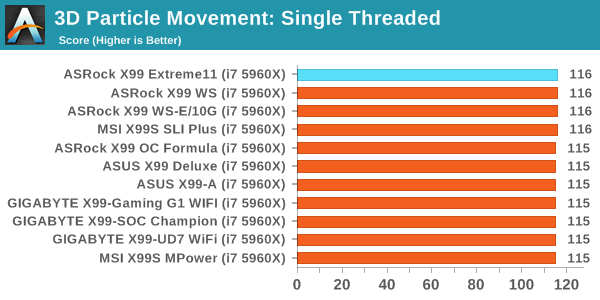
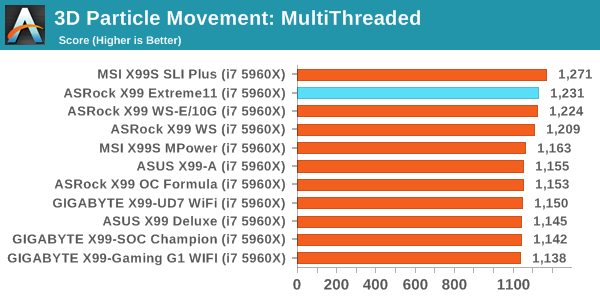
Compression – WinRAR 5.0.1: link
Our WinRAR test from 2013 is updated to the latest version of WinRAR at the start of 2014. We compress a set of 2867 files across 320 folders totaling 1.52 GB in size – 95% of these files are small typical website files, and the rest (90% of the size) are small 30 second 720p videos.
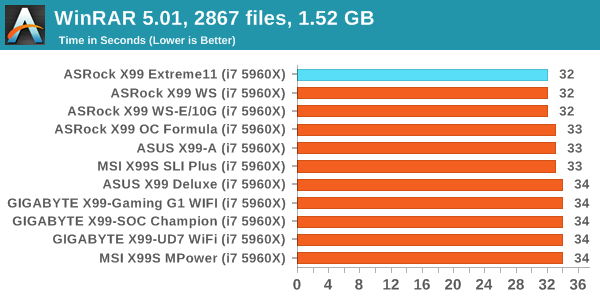
Image Manipulation – FastStone Image Viewer 4.9: link
Similarly to WinRAR, the FastStone test us updated for 2014 to the latest version. FastStone is the program I use to perform quick or bulk actions on images, such as resizing, adjusting for color and cropping. In our test we take a series of 170 images in various sizes and formats and convert them all into 640x480 .gif files, maintaining the aspect ratio. FastStone does not use multithreading for this test, and thus single threaded performance is often the winner.
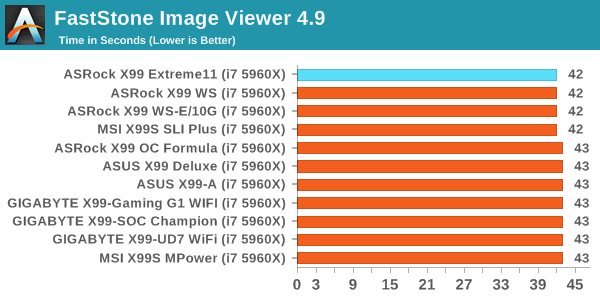
Video Conversion – Handbrake v0.9.9: link
Handbrake is a media conversion tool that was initially designed to help DVD ISOs and Video CDs into more common video formats. The principle today is still the same, primarily as an output for H.264 + AAC/MP3 audio within an MKV container. In our test we use the same videos as in the Xilisoft test, and results are given in frames per second.


Rendering – PovRay 3.7: link
The Persistence of Vision RayTracer, or PovRay, is a freeware package for as the name suggests, ray tracing. It is a pure renderer, rather than modeling software, but the latest beta version contains a handy benchmark for stressing all processing threads on a platform. We have been using this test in motherboard reviews to test memory stability at various CPU speeds to good effect – if it passes the test, the IMC in the CPU is stable for a given CPU speed. As a CPU test, it runs for approximately 2-3 minutes on high end platforms.
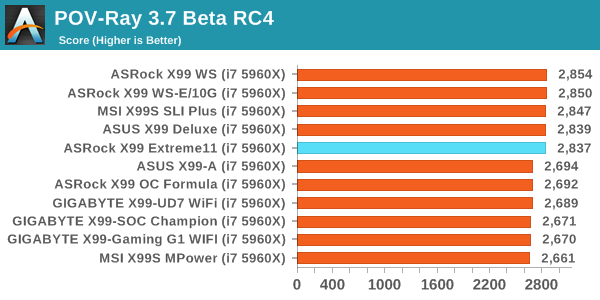
Synthetic – 7-Zip 9.2: link
As an open source compression tool, 7-Zip is a popular tool for making sets of files easier to handle and transfer. The software offers up its own benchmark, to which we report the result.
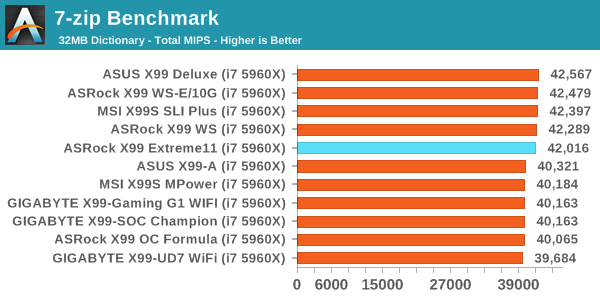










58 Comments
View All Comments
Vorl - Wednesday, March 11, 2015 - link
ahh, like I said, I might have missed something. Thanks!I was just looking at the haswell family and know it does support IGP. I didn't know that 2011/-E doesn't
yuhong - Saturday, March 14, 2015 - link
Yea, servers are where 2D graphics on a separate chip on the motherboard is still common.Kevin G - Wednesday, March 11, 2015 - link
Native PCIe SSDs or 10G Ethernet controllers would make good use of the PCIe slots.A PCIe slot will be necessary for graphics, at lest during first time setup. Socket 2011-3 chips don't have integrated graphics so it is necessary. (It is possible to setup everything headless but you'll be glad you have a GPU if anything goes wrong.)
As for why use the LSI controller, it is a decent HBA for software RAID like those used under ZFS. For FreeNAS/NAS4Free users, the numerous number of ports enables some rather larger arrays or features like hot sparing or SSD caching.
Vorl - Wednesday, March 11, 2015 - link
for 10G Ethernet controllers/Fiber HBAs you only need (need is such a strong word too, considering 10g ethernet, and 8gb fiber only need 3 and 2 lanes respectively for PCIe 2.0.) 8x slots. for super fast PCIe storage like SSDs you only need 4x slots which is still 2GB/s for PCIe 2.0 They would have been better served adding more PCIe 8x slots, but then again, what would be the point of 18 SATA slots if you were going to add storage controllers in the PCIe 16x slots?The 4x16 PCIE x16 slots makes me think compute server, but that doesn't mesh with 18 SATA ports. If the database engines were able to use graphics cards now (which I know is being worked on) this system might make more sense.
It still makes me think they just tried to slap a bunch of stuff together without any real thought about what the system would really be used for. I am all for goign fishing and seeing what people would use a board like this for, except that the $600 price tag put's it out of anyone but the most specialized use cases.
As for the LSI controller, like someone mentioned above, you can get a cheaper board with 8x sata PCIe cards to give you the same number of ports. More ports even since most boards these days come with 6x sata 6Gbs connections The 1mb of cache is so silly for the LSI chip that it's laughable.
The 128mb of cache for the RAID controller is a little better, but again, with just 6 RAID ports, what's the point?
The whole board is just a mess of confusion.
3DoubleD - Wednesday, March 11, 2015 - link
Similar to my thinking in my post above.If you are going for a software RAID setup with a ludicrous number of SATA ports, you can get a Z97 board with 3 full PCIe slots (x8,x8,x4) with 8 SATA ports. With three supermicro cards (two 8x SATAIII and one 8x SATAII because of the x4 PCIe slot) you would have 32 SATA ports and it would cost you $650. The software raid I use "only" accepts up to 25 drives, so that last card is only necessary if you need that 1 extra drive, so for $500 you could run a 24 drive array with a M.2 or SATA Express SSD for a cache/system drive. And as you pointed out, since it is Z97, it would have on board video.
Basically, given the price of these non-RAID add-in SATA cards, I'd say that any manufacturer making a marketing play on SATA ports needs to keep the cost of each additional SATA port to <$20/port over the price of a board with similar PCIe slot configurations.
As you said, if this board had 18 SATA ports that could support hardware RAID, then it would be worth the additional price tag. This is probably not possible though since 10 SATA ports are from the chipset and the rest from an additional controller. For massive hardware RAID setups your better off getting a PCIe 2.0 x16 card (for 16 SATAIII drives) or a PCIe 3.0 x16 card (if such a thing even exists, it could theoretically handle 32 SATAIII drives). I'm sure such large hardware RAID arrays become overwhelming for the controller and would cost a fortune.
Anyway, this must be some niche prosumer application that requires ludicrous amounts of non-RAID storage and 4 co-processor slots. I can't imagine what it is though.
Runiteshark - Wednesday, March 11, 2015 - link
No clue why they didn't do a LSI 3108 and have the port for the add on BBU and cache unit like Supermicro does on some of their boards. Also not sure why these companies can't put 10g copper connectors at minimum on these boards. Again, supermicro does it without issue.DanNeely - Wednesday, March 11, 2015 - link
There're people who think combining their gaming godbox and blueray rip mega storage box into a single computer is a good idea. They're the potential market for a monstrosity like this.You know what they say, "A fool and his money will probably make someone else rich."
Murloc - Wednesday, March 11, 2015 - link
I guess this is aimed at the rather unlikely situation of someone wanting both storage and computation/gaming in the same place.You know, there are people out there who just want the best and don't care about wasting money on features they don't need.
Zak - Thursday, March 12, 2015 - link
I agree. For reasons Vorl mentioned this is a pointless board. I can't imagine a target market for this. My first reaction was also, wow, beastly storage server. But then yeah, different controllers. What is the point?eanazag - Thursday, March 12, 2015 - link
It is not a server board. Haswell-E desktop board. I have no use for that many SATA ports but someone might.2 x DVD or BD drives
2 x SSDs on RAID 1 for boot
Use Windows to mirror the two below RAID 0 volumes.
7 x SSDs in RAID 0
7 x SSDs in RAID 0
The mirrored RAID 0 volumes could get you about 3-6 GBps transfer rates on reads from a 400 MBps SSD in sequential read. Maybe a little less in write speeds. All done with mediocre SSDs.
This machine would cost over $2000.